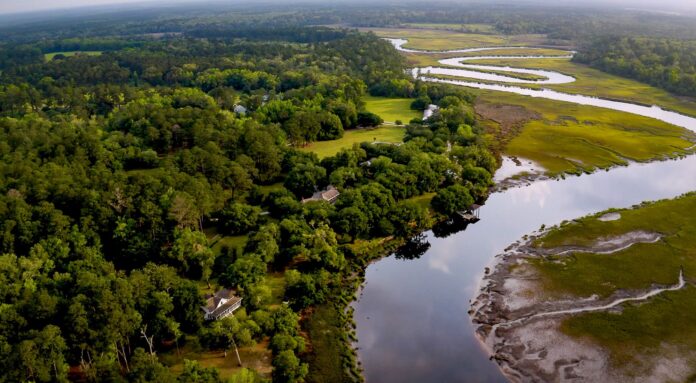The S.C. Nature Conservancy acquired one of the largest undeveloped waterfront properties in coastal S.C. back in February. The purchase will ensure permanent protection for the 4,409-acre Gregorie Neck property with a conservation easement ensuring the Lowcountry wetlands are protected from future development. Flanked by deep water access on the Coosawhatchie and Tulifiny Rivers and bisected by Interstate 95, the property was listed for sale in 2023.
The S.C. Nature Conservancy paid $35 million for the 4,409 acre piece of land. The conservation easement was finalized on July 25, 2024, and is a momentous achievement in the continuing efforts to protect South Carolina’s natural resources.
Located in the heart of the Port Royal Sound and in proximity to MCAS Beaufort’s flight paths, this property was under increasing pressure from potential overdevelopment due to its access to major transportation and commercial markets. The effort to acquire and protect Gregorie Neck, which began in 2023, culminates in the permanent protection of this critical area through a permanent conservation easement. The land will now be safeguarded from development pressures that could negatively impact the region’s ecosystem.
The Nature Conservancy in South Carolina secured an agreement with the Beaufort County Open Land Trust to place property under a conservation easement. The easement will permanently limit development of the property to no more than six homesteads, each with a limited number of structures.
A collaborative cost-sharing effort helped to make the successful acquisition and protection of Gregorie Neck possible. The Department of the Navy contributed $6 million toward the easement through the Readiness and Environmental Protection Integration Challenge Program to prevent incompatible development and preserve landscapes vital to military readiness.
This award, the first and largest of its kind in the Lowcountry, reflects over two decades of successful partnership. The remaining $7.5 million required to finalize the protection was provided by the State of South Carolina Conservation Bank, Beaufort County Greenspace Program, and a portion of TNC’s generous donation as landowner.
“Closing the conservation easement means that protection now extends forever, no matter who owns this property in 10, 20 or 100 years. This is a conservation win for today and for the future,” said Dale Threatt-Taylor, executive director, TNC in South Carolina.
“Unlike so many miles of waterfront in our state, the future of Gregorie Neck now is certain,” Dale Threatt-Taylor, executive director of The Nature Conservancy in South Carolina. “The very limited development allowed by this approach will leave thousands of acres of marsh, woods and fields intact for wildlife and water quality.”

One of the players was the Department of Defense, which is particularly interested in ensuring limited development for the good of national security. The Sentinel Landscape Partnership is a coalition of federal agencies, state and local governments, and non-governmental organizations that work with willing landowners and land managers to advance sustainable land use practices around military installations and ranges, according to the partnership’s website.
The permanent restrictions outlined in the terms of the Gregorie Neck conservation easement will decrease the property’s value, a loss that is largely offset by a diversity of funding partners through competitive grants.
This easement also provides significant ecological benefits, including the protection of 13.5 miles of riverfront and salt marsh habitat within the Port Royal Sound watershed.
“The diversity of grant funds applied toward this conservation easement indicate its tremendous value: protection of downstream water quality, protection of critical habitat, and protection of important military flight space above,” said Kristin Williams, executive director, OLT.
These protected lands will contribute to the resilience of the local ecosystem, preserving crucial wildlife corridors between the Ashepoo, Combahee, and Edisto River (ACE) Basin and the Savannah River, and enhancing the area’s ability to withstand the impacts of hurricanes and destructive weather, including storm surges and subsequent flooding.
“This region is experiencing such intense growth; when we saw the opportunity to protect a property like this — with so much water frontage and direct interstate access — we knew we had to make it happen,” Threatt-Taylor said in the release. “Developing Gregorie Neck would have had a huge impact on this region’s nature and wildlife, as well as its infrastructure needs and traffic. Instead, we hope this project now will accelerate regional land protection efforts. This closing is an achievement made possible by a conservation-minded seller, creative real estate professionals and committed funding partners.”
A portion of Gregorie Neck lies in the battlefield footprint of the Battle of Tulifiny, a Civil War battle fought during Major General Sherman’s March to the Sea. The Confederacy was represented by 900 men, including the entire Corps of Cadets of the South Carolina Military Academy (The Citadel), marking the only time that the entire student body of a U.S. college fought in combat.
Gregorie Neck, named for Alexander Gregorie who acquired the property in 1798, has been managed for the last 30 years by the Jepson family to promote the property’s conservation values. Upland forests have massive pines and hardwoods that have not been harvested in many decades, the release said. Impoundments along the rivers’ edges provide critical habitat for wading birds and migratory waterfowl. Open agricultural fields support livestock and songbirds.
“The variety and condition of Gregorie Neck’s ecosystems are remarkable,” David Bishop, coastal and midlands conservation director for the S.C. Nature Conservancy, said in the release. “But even more significant is how this property fits into the growing green band connecting the undeveloped lands in the Savannah River Basin with those in the ACE Basin. That band is under intense development pressure and is critical to protect water quality in Port Royal Sound and ensure wildlife have enough healthy habitat.”
To the east of Gregorie Neck, across the Tulifiny River, is Mackay Point, 6,736 acres under conservation easement with Lowcountry Land Trust. To the northwest is the 12,000-acre Buckfield assemblage, protected by The Nature Conservancy and Open Space Institute.
With all the growth in the area, we’re so happy to see that more Lowcountry wetlands are protected.










